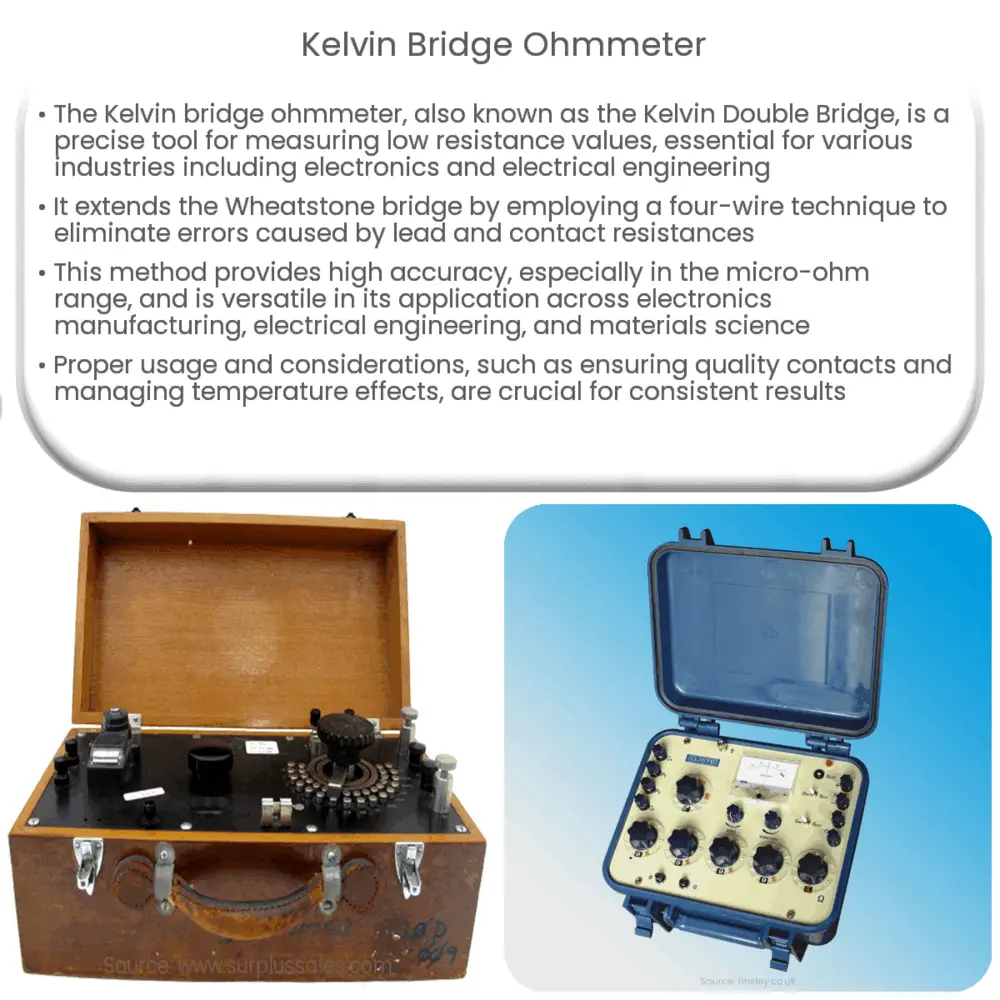The Kelvin bridge ohmmeter is a highly accurate instrument for measuring low resistance values, widely used in electronics, electrical engineering, and materials science.

Kelvin Bridge Ohmmeter: A Comprehensive Guide
Introduction
The Kelvin bridge ohmmeter, also known as the Kelvin Double Bridge or Kelvin’s four-wire resistance measurement technique, is a highly accurate and sensitive instrument used for measuring low resistance values. The Kelvin bridge is an essential tool for engineers, technicians, and researchers in various fields such as electronics, electrical engineering, materials science, and quality control. In this article, we will discuss the principles behind the Kelvin bridge, its advantages, and its applications.
Principle of Operation
The Kelvin bridge is an extension of the Wheatstone bridge, a widely known circuit used for measuring unknown resistance by balancing the ratio of two legs of a bridge circuit. The Wheatstone bridge consists of four resistances in a diamond configuration with a galvanometer connected between the two junctions, and a known voltage source applied across the bridge. When the bridge is balanced, no current flows through the galvanometer, and the unknown resistance can be calculated using the known resistance values and their ratios.
However, the Wheatstone bridge is not suitable for measuring very low resistance values due to the lead and contact resistances that introduce errors in the measurement. To overcome this limitation, the Kelvin bridge incorporates a four-wire technique that eliminates the effects of lead and contact resistances. In a Kelvin bridge, four connections are made to the unknown resistance, with two connections supplying current (I) and the other two connections measuring the voltage drop (V) across the unknown resistance. The basic equation for resistance (R) is R = V/I, and by measuring the voltage drop across the unknown resistance, independent of the current-carrying leads, the Kelvin bridge can accurately determine low resistance values.
Advantages of Kelvin Bridge Ohmmeter
The Kelvin bridge offers several advantages over other resistance measurement techniques, making it the go-to method for measuring low resistances. These advantages include:
- High Accuracy: By eliminating the effects of lead and contact resistances, the Kelvin bridge provides highly accurate measurements for low resistance values, even in the micro-ohm range.
- Wide Range: The Kelvin bridge can measure resistance values ranging from micro-ohms to several ohms, making it a versatile tool for various applications.
- Simple and Robust: The Kelvin bridge is a relatively simple and robust instrument, making it suitable for use in both laboratory and field settings.
- Low Temperature Coefficient: The Kelvin bridge has a low temperature coefficient, meaning it can maintain its accuracy over a wide temperature range, making it suitable for temperature-sensitive applications.
Applications of Kelvin Bridge Ohmmeter
Thanks to its high accuracy and wide measurement range, the Kelvin bridge ohmmeter finds numerous applications in various industries and fields. Some of the most common applications include:
- Electronics Manufacturing: The Kelvin bridge is used for measuring the resistance of electronic components, such as resistors, conductive tracks on printed circuit boards, and connectors, to ensure they meet specifications and maintain product quality.
- Electrical Engineering: In the field of electrical engineering, the Kelvin bridge is employed for measuring the resistance of conductors, such as wires, cables, and busbars, as well as determining the contact resistance of connectors, switches, and relays.
- Materials Science: Researchers in materials science use the Kelvin bridge to investigate the electrical properties of various materials, including metals, semiconductors, and superconductors, which can help develop new materials and improve existing ones.
- Power Distribution: The Kelvin bridge is used to measure the resistance of power distribution components, such as transformers and circuit breakers, to ensure their proper functioning and prevent potential failures.
- Quality Control: In quality control and assurance, the Kelvin bridge ohmmeter is used to test the electrical properties of finished products and components, ensuring they meet the required standards and specifications.
Important Considerations When Using a Kelvin Bridge Ohmmeter
While the Kelvin bridge ohmmeter offers numerous advantages and is a reliable instrument for measuring low resistance values, there are some important considerations to keep in mind when using this device:
- Proper Connections: It is essential to ensure that the four connections to the unknown resistance are made correctly, as improper connections can lead to inaccurate measurements.
- Contact Quality: The quality of the contacts between the Kelvin bridge and the unknown resistance plays a significant role in obtaining accurate measurements. Clean, stable contacts are necessary for reliable results.
- Temperature Effects: Although the Kelvin bridge has a low temperature coefficient, extreme temperature changes can still affect measurements. It is advisable to perform measurements under stable temperature conditions, or to use a temperature compensation method when necessary.
- External Interference: Electromagnetic interference and noise can affect the accuracy of the Kelvin bridge measurements. It is crucial to use shielded cables and maintain an appropriate distance from sources of electromagnetic interference when performing measurements.
Conclusion
In summary, the Kelvin bridge ohmmeter is a highly accurate and versatile instrument for measuring low resistance values. By eliminating the effects of lead and contact resistances, it offers reliable measurements across a wide range of applications. However, it is essential to consider proper connections, contact quality, temperature effects, and external interference when using the Kelvin bridge to ensure accurate and consistent results.

